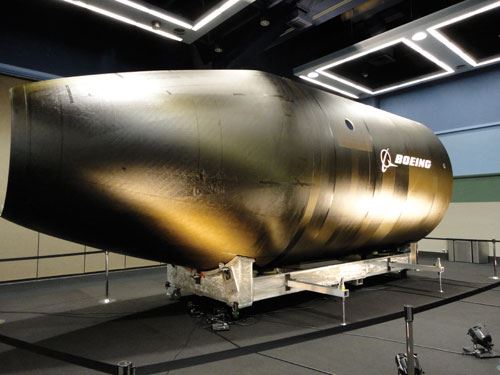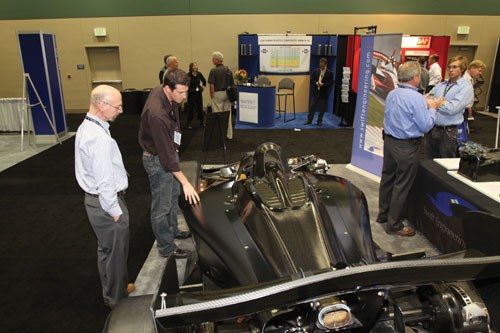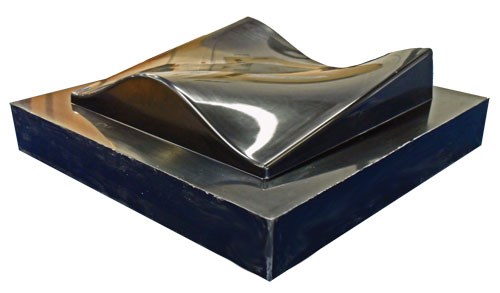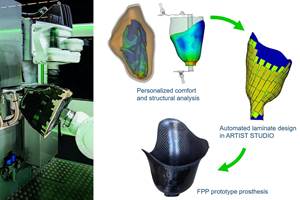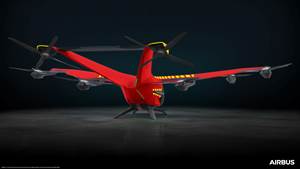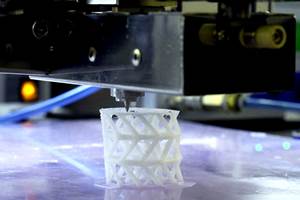SAMPE 2010 Seattle Showcase
SAMPE’s first-ever foray into Boeing Country wrapped up with the M&P organization’s biggest draw this decade.
More than 5,000 material & process professionals were in attendance at the Washington State Convention Center. A total of 300 companies exhibited, 70 of which were first-timers. For the Society for the Advancement of Material and Process Engineering’s (SAMPE, Covina, Calif.) Spring Conference and Exhibition — held for the first time in Seattle, Wash. — this was a strong turn out in good times and even more impressive in the shadow of the worst recession since the Great Depression.
SAMPE officials were understandably pleased with the statistics and, as if in anticipation of the stellar turnout, had assembled a large slate of keynote speakers and special lecturers as well as 350 technical presentations for the four-day conference (May 17-20) — 100 more than in recent years.
Befitting the show’s location, Frank Doerner, VP – materials, processes & structures technologies at Seattle-based Boeing Research & Technology, was the keynote speaker the morning of May 19. He brought the audience up to speed on the 787 Dreamliner as it moves through flight testing prior to anticipated type certification by the Federal Aviation Admin. (FAA), and then first delivery later this year. Doerner identified several challenges associated with composites work on the 787: Design and analysis, EMI shielding, heat distribution (composites tend to insulate), tooling (big and complex), production (multiple composites suppliers) and repair methods. He identified several areas of interest on the horizon for Boeing: Out-of-autoclave (OOA) materials, next-generation prepregs, toughened infusion resins, increased use of thermoplastics, micro-crack resistance (especially for space applications), high-temperature systems and adhesives. Adhesives are of particular interest, he said, because they can help Boeing eliminate the use of mechanical fasteners, saving both weight and assembly time.
Doerner also commented on the forthcoming replacement for Boeing’s workhorse 737 jet, noting that Boeing is still assessing composites use on that aircraft. The speed of composites manufacturing processes is a primary factor here, given the higher production rate typical with single-aisle aircraft. If composites are used on the 737, therefore, Doerner suggested that they might not be used in the same way they are employed on the 787.
Conference topics included natural materials, design and analysis, tooling, repair, and nondestructive evaluation and out-of-autoclave technology.
The latter was a hot topic in the conference sessions and on the show floor. Notable among the OOA papers was HITCO Carbon Composites Inc.’s (Gardena, Calif.) on OOA cure of parts produced via automated tape laying (ATL). The presentation outlined work done with a MAG (Hebron, Ky.) Charger tape laying machine using 3-, 6-, and 12-inch prepreg tape, Cycom 5320 provided by Cytec Engineered Materials (Tempe, Ariz.). The Charger has an ultrasonic cutter and a 100-psi compaction head. HITCO tested material with three levels of impregnation: low, medium and high. Test panels were produced for each material type, then bagged and cured at 200°F/93°C in an oven. Results, says HITCO, showed that open-hole tension and compression were on par with parts cured in an autoclave. Low-impregnation material provided the best consolidation. OOA cure, HITCO determined, is viable for ATL applications.
SAMPE officials announced that SAMPE 2011 will be sponsored by SAMPE’s Orange County Chapter and will return to its home base in Long Beach, Calif., May 23-26, 2011. In a new twist, the event will be colocated with Aeromat 2011. For further information, contact Michelle Tubb at (626) 331-0616 x603; E-mail: michelle@sampe.org.
As always, HPC operatives were on hand, and filed the following reports about notable products, technologies and services in evidence on the show floor.
_______________________________________________________________________
Braided prosthetics, braided thermoplastics
A&P Technology Inc. (Cincinnati, Ohio) described its partnership with Toray Composite Materials America Inc. (Flower Mound, Texas) to help earthquake survivors in Haiti. The company braided 4-inch, 5-inch and 6-inch (101-mm, 127-mm and 152-mm) sleeves (using Toray fibers) for the manufacture of thousands of prosthetic devices, which were provided to groups that are providing Haitian medical relief – A Leg to Stand On (ALTSO) and MedShare. The company also highlighted its expertise in braided thermoplastics, which are finding new application thanks to inherent flame, smoke and toxicity (FST) properties, quick cycle times, toughness, infinite shelf life and recyclabililty.
_______________________________________________________________________
New name, fully integrated services
AAR Precision Systems (Clearwater, Fla.) is the new name for the entity comprising AAR Composites and recently acquired Summa Technologies. The new firm now offers fully integrated design, engineering and manufacturing services for composite aerostructures and assemblies, including fabrication, testing and precision 5-axis machining. The company was recently selected by Bombardier Aerospace to design and manufacture the flap track fairings for the CSeries family of commercial aircraft.
_______________________________________________________________________
New resins and vacuum-bagging materials
Airtech International Inc. (Huntington Beach, Calif.) showcased several new products introduced at the JEC Show in Paris, including Beta Prepreg based on Henkel Corp. (Madison Hts., Mich.) benzoxazine resin and Toolfusion 3, a nano-particle enhanced resin system for out-of-autoclave composite tooling; Dahltexx SP-2, a semipermeable fabric-supported membrane for toolside and bag side breathing; Airdraw 2, a new, stiffer vacuum bagging film that is not affected by humidity; super wide vacuum bagging films for very large composite parts; and several innovative yet cost-effective products that provide internal pressure for hollow sections.
_______________________________________________________________________
3-D performs for closed molding
Albany Engineered Composites Inc. (Rochester, N.H.) reported that it has seen rapid growth in its aerospace business and is ramping up production of aerospace parts. The company showed its range of engineered materials including three-dimensional (3-D) preforms targeted for closed molding processes, and its parts manufacturing expertise for primary and secondary aerospace structures.
_______________________________________________________________________
Versatile flatbed cutting system
Cutting table manufacturer Autometrix Inc. (Grass Valley, Calif.) brought to the show its new Model M8 system. It features a carbon fiber gantry for high speed and light weight; 66-inches/sec (1.68 m/sec) cutting speed; LCD touch screen control system; PatternSmith software; servomotors on XA, XB, Y and Theta axes; five available widths, up to 120 inches/3,048 mm, and more than 100 lengths, 8 to 80 ft (2.4 to 24.4m); a single-roll material rack; and optional airdrill, inkjet marking system, vacuum table zoning and additional racks.
_______________________________________________________________________
New build-to-print facility
Burnham Composite Structures Inc. (Wichita, Kan.) new facility was a topic of discussion at the company’s booth. Built to accommodate expanding demand for Burnham’s build-to-print manufacturing services for Boeing and other aircraft OEMs, the 16,000 ft² (1,486m²) facility accommodates a 2,000 ft2 (186m2) Class 400,000 cleanroom; two computer controlled ovens (largest is 20 ft by 15 ft by 6 ft or 6.1m by 4.6m by 1.8m), compression molding presses (150-ton, 200-ton, 400-ton) with up to 4 ft by 10 ft (1.2m by 3m) platens; a 750-ton multi-platen press, with 5 ft x 12 ft (1.5m by 3.7m) platens; a 500-ton single-platen press, with 5 ft x 16 ft (1.5m by 4.9m) platens; and a 4,000 ft² (372m²) assembly area.
_______________________________________________________________________
Infusion epoxy for room-temperature cure
CRG (Cornerstone Research Group Inc.) (CRG, Dayton, Ohio) introduced a room-temperature-cure epoxy system for out-of-autoclave, out-of-oven infusion processes, with controllable exotherm for very thick and large part. The epoxy reportedly has a glass transition temperature (Tg) of 350°F/177°C, says the company. It is looking for strategic partners to trial the “capability” (including the resin system, layup and part-curing process) and is considering licensing the technology.
_______________________________________________________________________
Electro-conductive materials for composites
Eeonyx Corp. (Pinole, Calif.) demonstrated a range of fabrics and foams that conduct electricity when coated with the company’s inherently conductive polymers and nano-coatings. Applications for the composites industry include pressure sensitive coatings, treatment of wind turbine blades to reduce radar cross-section and stealth applications.
_______________________________________________________________________
Modular fiber placement machine
Electroimpact Inc. (Mukilteo, Wash.), a relative newcomer to the fiber and tape placement machinery market, exhibited its 16-spool, modular placement machine at the show. Company officials reported that two of its machines are in operation at Spirit AeroSystems (Wichita, Kan.), where they are used to manufacture the Section 41 forward fuselage for the Boeing 787 Dreamliner. The machines use third-party, offline programming-code software supplied by show exhibitor CGTech (Irvine, Calif.).
_______________________________________________________________________
Flatbed cutter for reinforcements and prepregs
First-time exhibitor Gunnar USA Inc. (Arlington, Wash. and Rebstein, Switzerland) exhibited its new TTC119 technical textile flat table cutter. According to the company, the high–speed, single-layer cutter is built to work in all production environments, cutting flat technical materials including prepregs, dry carbon, glass fibers and aramid fibers, etc. as well as sheet materials such as foam. Two table sizes are available and cutting is accomplished with either a drag knife or rotary cutter. The TTC119 recognizes any data formats and has an optional wireless control unit.
_______________________________________________________________________
Curing systems for composite repairs
HEATCON Composite Systems (Seattle, Wash.) highlighted two new systems: the HCS8000 series “microbonder,” is a small portable curing controller targeted to the factory floor for small, localized repairs during production. For larger repairs, several microbonders can be networked together to create sufficient power for a large area. Also, the HCS3100 series portable autoclave or “repair clave” is available for quick repair of critical structures, such as helicopter blades. The company also provides composite repair training throughout the U.S., Europe and Asia.
_______________________________________________________________________
Benzoxazine resins and prepregs
Henkel Corp. (Madison Heights, Mich.) introduced to North America its line of Benzoxazine 99110 resins. The material was a finalist in an A380 part at the JEC Composites show Innovation competition in Paris and is offered as a replacement for epoxy and bismaleimide. It provides good mechanical, temperature and fire performance. In addition, Henkel has partnered with Airtech International Inc. (Huntington Beach, Calif.) to offer carbon fiber prepregs for the manufacture of composite tooling using the Benzoxazine resin. Tools made with the material are said to offer good dimensional control and vacuum integrity.
_______________________________________________________________________
Small-denier/high-tensile-strength carbon fiber
Hexcel (Dublin, Calif.) displayed a Sikorsky S-76D main rotor blade, which incorporates Hexcel materials and blade production concepts, and exhibited its new Hextow IM10 carbon fiber (introduced earlier this year at the JEC Composites Show in Paris). The new “breakthrough” small-denier fiber, a product of the company’s legacy intermediate-modulus fiber technology, exhibits a tensile strength of more than 1,010 ksi (reportedly the highest commercially available tensile strength) and a tensile modulus of 44 Msi, with a tensile strain of 2.1 percent. Also on display: HexPly M91 prepreg, a toughened, high-strength prepreg with high residual compression after impact (CAI) performance. It was designed specifically for automated processing and is supplied in tape form. The company also recently introduced HexForce bias-weave fabrics for ±45° layup applications.
_______________________________________________________________________
Automated composites manufacturing services
HITCO Carbon Composites Inc. (Gardena, Calif.) presented its “automation journey” to booth visitors, highlighting its recent migration to automated manufacturing capabilities for aerospace manufacturing (HITCO’s Dr. Les Cohen makes some observations about automation as a means to meet the challenges of composites manufacturing, in this issue's “Speaking Out” op/ed column. See "The digital thread: Transfromaiton to automation," under "Editor's Picks,"at right. The company is producing structures for the F-35 fighter and floor beams for the Boeing 787 Dreamliner, as well as many other aerostructures.
_______________________________________________________________________
New resins, adhesive and hardener
Huntsman Advanced Materials (The Woodlands, Texas) showcased a series of new epoxy and benzoxazine resins for high-performance aerospace composites. Among them was low-viscosity Araldite MY0816 naphthalene diepoxy, targeted for formulating infusion, resin transfer molding (RTM), prepreg, adhesive and syntactic systems, combining a very high Tg and high toughness with low moisture absorption and low dielectric constant. Also in the spotlight: Araldite AW 4856/Hardener HW 4856 is a short-fiber glass-reinforced epoxy adhesive system with nano-enhanced toughness, chemical thixotropy and low exotherm, for large composite parts, including wind blades and boat hulls. Lastly, the company’s new low-melt-point diaminodiphenylsulfone (DDS) curative/hardener reportedly processes at a lower temperature, with a lower melt viscosity, making it an option for infusion processes.
_______________________________________________________________________
Photo-resist services for powder-blast machining
IKONICS Advanced Material Solutions (Duluth, Minn.) attracted attention with its powder-blasting technology for machining and finishing. The process involves Aeromask, a photo-resist masking film that is imaged, via light exposure, with the customer’s design for production blasting. The unexposed mask is removed from areas to be blasted, while it protects the rest of the part. Blasting reportedly can produce accurate, burr-free holes in flat or curved parts without delamination in a fraction of the time required for traditional drilling. The company provides the technology as well as the actual part machining.
_______________________________________________________________________
In-process inspection for AFP
Ingersoll Machine Tools Inc. (Rockford, Ill.) discussed its new Real-Time Inspection System (RTIS) option for automated fiber placement systems. Designed to work in-head, the inspection system is being developed to identify possible tow anomalies before the fiber is fed to the compaction roller. Such anomalies would include tow-width error, twisted tows, material splices, tow absence, tow-feeding problems, etc. The operator or programmer can choose from a number of actions to fix or track these anomalies automatically or manually.
_______________________________________________________________________
Design/manufacturing/testing services
Integrated Technologies Inc. (INTEC) (Intec, Everett, Wash.) shared booth space with its parent company LMI Aerospace (St. Charles, Mo.). Acquired by LMI in January 2009, Intec is LMI’s composites division. It provides part manufacturing, design and testing services. Intec recently constructed a 3,500 ft² (325m²) Class 10,000 cleanroom and purchased an automated ply cutter (supplied by Gerber Technology, Tolland, Conn.), an 8-ft Romer inspection arm, and a laser ply locator system as part of LMI Aerospace’s continuing support and commitment to expand Intec’s composite part production capability.
_______________________________________________________________________
Phenolic prepregs meet FAR Part 25 FST
Lewcott Corp. (Millbury, Mass.) exhibited its expanded LC family of phenolic prepreg products for aircraft interiors. Lewcott, which manufactures its own high-molecular-weight phenolic resins, says the prepreg resin can be tailored for a variety of processes and meets Federal Aviation Regulations (FAR) Part 25.853 and many other flame, smoke and toxicity (FST) metrics. Also on display was the company’s new FM5LF polyester prepreg for composite radome and antenna applications.
_______________________________________________________________________
Epoxies for aircraft interiors, repairs and spacecraft
Magnolia Advanced Materials Inc. (Chamblee, Ga.) introduced three new epoxy products. Its two-part 132-488 A/B is a low-viscosity resin designed specifically for resin transfer molding (RTM) applications. Made for aircraft interiors and will see first use on stair steps for a corporate jet, the epoxy has an eight-hour pot life, is fire-resistant and meets Federal Aviation Regulations (FAR) Part 25.853(A) 60-second vertical burn test requirements (three-ply laminate). Two-part 7590 A/B is a wet layup epoxy designed for composite repairs. It cures at 250°F to 300°F (121°C to 149°C), has a pot life of at least five hours, offers good high-temperature performance and is being evaluated for military repair applications. The company’s 7500 A/B adhesive, designed for wetting out carbon fiber and glass fiber materials, is intended primarily for space applications and has a four-hour pot life. At a 2:1 mix ratio, by volume, it provides good peel and shear properties.
_______________________________________________________________________
Circuitry for composite health monitoring
MesoScribe Technologies (St. James, N.Y.), also a first-time SAMPE exhibitor, offered an interesting “direct write process” technology, in which a plasma beam or “plume” deposits metallic material onto composite or metallic material to create structurally integrated electronic circuits. The microscopic process has direct application for structural health monitoring of composite parts, as well as integral antennae or precision coatings.
_______________________________________________________________________
Nanotechnology Transition awardees
NanoSperse LLC (Kettering, Ohio), a designer, developer and supplier of nano-enhanced materials using technology licensed from the University of Dayton Research Institute with support from the Air Force Manufacturing Technology Initiatives, announced winners of its sponsored “Nanotechnology Transition Awards.” Recipients were Renegade Materials Corp. (Springboro, Ohio; highlighted below) and North Coast Composites Inc. (Cleveland, Ohio). Renegade has launched a nano-enhanced electrically conductive film for use in composite structures, while North Coast incorporated a Nanosperse sand-erosion protection film for a composite aircraft engine part.
_______________________________________________________________________
Combined core/reinforcement
Parabeam BV (Helmond, The Netherlands) showed its range of Parabeam 3D glass fabrics, made with E-glass yarns and consisting of two deck layers connected with vertical plies to form an integral sandwich. The material acts as both reinforcement and core layer, enabling resin flow through the open interior between the upper and lower skins. Parabeam is owned by underground tank manufacturer ZCL Composites Inc. (Edmonton, Alberta, Canada), which uses the Parabeam material to form tis double-walled fiberglass tanks.
_______________________________________________________________________
Large-part machining center with built-in CCM
Machining specialist Paragon D & E (Grand Rapids, Mich.) emphasized its large-part, high-speed, high-precision Fidia Y2G machining center. The 5-axis, two-spindle machine measures an impressive 12 by 60 by 10 ft (3.7 by 18.3 by 3m) and is used to produce tooling, machine wind blades and aircraft structures and other large parts. It features a built-in coordinate measuring machine (CMM) with which to conduct self-inspections and offers machining accuracy to within 0.001 inch/0.025 mm.
_______________________________________________________________________
New materials, new parts production services
Park Electrochemical Corp. (Melville, N.Y.) introduced E-710 easy-cure epoxy prepreg, and E-710FR, a flame-retardant version. Both feature a low cure temperature of 160°F to 250°F (71°C to 121°C) and are said to provide good mechanical properties with medium toughness and long out-time (60 days) at room temperature. Available reinforcements include carbon fiber, aramid and fiberglass in widths up to 60 inches/1,524 mm. Carbon fiber (3K tow) prepregged with E-710 offers these mechanical properties: tensile strength, 115 Ksi; tensile modulus, 7.9 Msi; compressive strength, 86 Ksi; compressive modulus, 7.5 Msi; flex strength, 126 Ksi; flex modulus, 7.6 Msi; short-beam shear strength 7.6 Ksi.
Also new: Aeroglide surfacing film, an epoxy-based composite film that can be oven or autoclave cured at 250°F/121°C or 350°F/177°C to eliminate surface porosity. It provides a paintable surface, good tack and drapability, is co-curable with most epoxy prepregs, is UV-resistant and is compatible with lightning strike screens and foils.
The company also announced that it now offers parts fabrication services at two locations, one in its new Newton, Kan., plant, and the other in Lynnwood, Wash. Services include prototype to volume production, build-to-print fabrication, part and tooling design, autoclave-cure, oven-cure, filament winding, trim and drill and assembly. Emphasis is on aerostructures, including control surfaces, winglets, fairings, access doors and struts.
_______________________________________________________________________
Out-of-autoclave polyimide prepreg initiative
Renegade Materials Corp. (Springboro, Ohio) announced it had received a $1 million (USD) grant for the development of out-of-autoclave polyimide prepregs, aimed at making high-temperature polyimide materials more affordable under a broader array of processing methods. Renegade will collaborate with Maverick Corp. (Blue Ash, Ohio). The award, which will be matched by $1 million from Renegade, Maverick and participating customers, was made by the Ohio Third Frontier, a Ohio Department of Development program aimed at technology commercialization and jobs creation. Beyond current and military aerospace markets, potential applications include commercial and general aviation as well as automotive. The company is recruiting program participants. Interested parties should email inquires to lgray@renegadematerials.com.
_______________________________________________________________________
Reusable silicone vacuum bags
Smooth-On Inc. (Easton, Pa.) demonstrated the ease of producing reusable silicone vacuum bags using its EZ-Brush system. After the silicone system is mixed and degassed, it is applied to the tool surface to form a high-temperature and tear-resistant, reusable bag that reportedly pays for itself after eight parts. The company also manufactures EpoxAmite epoxy laminating resins many other products, and also offers technical assistance and training.
_______________________________________________________________________
New epoxy resin system for carbon prepregs
TenCate Advanced Composites (St. Paul, Minn.) introduced its Matrix Resin 3831, a high-performance epoxy system for carbon fiber composites. Designed for prepregs, it is said to provide good compression strength and help to minimize crack propagation. 3M tests comparing the new resin to standard epoxy showed a 76 percent improvement in shear modulus, 73 percent greater toughness and a 68 percent increase in Barcol hardness. Carbon fiber prepreg tapes manufactured using the new resin reportedly have the same processing characteristics as, and can be used in place of, comparable legacy prepregs in a manufacturer’s layup process without modifications. Cure is initiated at the same temperature and the resin has similar flow properties as typical 250°F/121°C cure prepreg resins.
_______________________________________________________________________
Out-of-autoclave surfacing film
TenCate Advanced Composites (Morgan Hill, Calif.) used the show to launch its TC235SF composite surfacing film for out-of-autoclave (OOA) vacuum bag cure. Part of a family of compatible resin systems designed for low- to moderate-cure temperatures in low pressure, vacuum-only environments, the new film has an out-time of 30 days and yields a cosmetically smooth appearance, even over thin-skinned honeycomb-cored composites. It also maintains its integrity in tight radii while providing low porosity, according to the company.
_______________________________________________________________________
Braided PPS aircraft seat frames
Ticona Polymers Inc. (Florence, Ky.) presented a technical paper at the SAMPE conference regarding use of its Fortron PPS resin in a braided reinforcement produced by A&P Technology Inc. (Cincinnati, Ohio) that is manufactured by Cutting Dynamics Inc. (CDI, Avon, Ohio) to form lightweight aircraft seat frames that far exceed the current flame, smoke and toxicity (FST) requirements for aircraft interiors. Also on display at the company’s booth was Celstran continuous fiber reinforced thermoplastic tapes for highly stressed components in offshore oil and aerospace applications. Celstran is also available in rod and profile forms.
_______________________________________________________________________
Three-phase syntactic foam
Trelleborg Applied Technologies (Mansfield, Mass.) brought a unique product to the show. EAM-UL (Energy-Absorbing Ultra-light) is a three-phase syntactic foam composed of carbon fiber-coated macroballoons in a rigid resin binder, engineered to optimize energy absorption in impaction and ablation applications. The macroballoons are sold by Trelleborg in 4-ft by 8-ft by 2-inch (1.2m by 2.4m by 51-mm) sheets, or can be molded to customer-requested shapes. Potential applications include infrastructure panels, void fill and core material. There are two grades of EAM-UL available, differentiated by density: 170 kg/m³ and 360 kg/m³. The former has a compressive modulus of 6.3 MPa and crush strength of 0.9 MPa. The latter has a compressive modulus of 60 MPa and a crush strength of 4.8 MPa.
_______________________________________________________________________
Aerospace & industrial adhesives distributor
Watkins and Assoc. Inc. (Lilburn, Ga.) chose to exhibit at the show to highlight the fact that the company is the largest U.S. distributor of Henkel adhesive products. It also distributes adhesives manufactured by 3M, ITW Plexus and Sika. The company divides its business activities between aerospace and industrial applications.
_______________________________________________________________________
Handheld hot-bonding cure controller
WichiTech Industries Inc. (Baltimore, Md.) showcased its handheld HB-1 Composite Repair System, which the company claims is the smallest yet most powerful and economical hot bonding cure controller in the composites repair industry. The 3.5-lb/1.6-kg unit has four thermocouple inputs and is easy to program.
_______________________________________________________________________
Nanoplatelets for composites
Composites industry newcomer XG Sciences Inc. (East Lansing, Mich.), a Michigan State University spinoff company, produces the xGnP line of exfoliated graphene nanoplatelets. Produced from mineral graphite in a proprietary process developed at MSU by Dr. Lawrence Drzal, the platelets consist of short stacks of one or more graphene sheets. Each particle has an average thickness of about 5 to 10 nm and lateral dimensions ranging in increments up to 50 microns in diameter. Surface area of the company’s Grade M particles is 120 to 150 m²/g. Thermal conductivity is 3,000 Watts/meter-k, tensile modulus is 1,000 GPa and tensile strength is 5 GPa (all parallel to surface). The nanoplatelets reportedly add functionality to composites, including higher modulus, thermal and electrical conductivity. The company is exploring new applications for the product, including possible use as in situ micro strain gauges or barrier coatings. XGnP is currently produced at the rate of 30 lb/13.6 kg of platelets per day, in 22-lb/10 kg batches, with a target of 1,000 lb/454 kg per day in the near future. The company has partnered with compounder Ovation Polymers Inc (Medina, Ohio), which has developed the ExTima line of masterbatches featuring xGnP nanoplatelets in thermoplastics, including polyetheretherketone (PEEK) and polyphenylene sulfide (PPS). Loadings of xGnP in these resin systems ranges from 3 to 8 percent.
_______________________________________________________________________
CNT-enhanced prepreg materials
Zyvex Technologies Inc. (Columbus, Ohio) showed its Arovex prepreg that incorporates carbon nanotubes and the company’s multifunctional molecular technology that allows nano-sized materials to fully bond with host polymers or materials. The company revealed that its Epovex nano-enhanced adhesives are now available in smaller cartridge form.
Related Content
Cevotec’s fiber patch placement is part of digital process chain for automated composite prosthetics
Multiple partners work to develop automated data collection, composite laminate generation for customized medical applications using FPP technology in German-funded Patch2Patient project.
Read MoreCityAirbus NextGen to be developed for future medical missions in Norway
Airbus and the Norwegian Air Ambulance Foundation partner to measure the added value of eVTOL aircraft for medical use cases across Norway.
Read MoreSCABAEGO project develops bioactive composite that supports healing of broken bones
Fraunhofer IFAM researchers and partners combine biodegradable polymer polycaprolactone and bioactive glass to 3D print custom-fit structures for bone fracture sites.
Read MorePost Cure: Natural mineral fiber biocomposite via AFP enhances implant integration
Arctic Biomaterials produces high-quality composite biomaterials incorporating a natural mineral fiber that is useful in medical and healthcare-related fields.
Read MoreRead Next
Developing bonded composite repair for ships, offshore units
Bureau Veritas and industry partners issue guidelines and pave the way for certification via StrengthBond Offshore project.
Read MoreVIDEO: High-volume processing for fiberglass components
Cannon Ergos, a company specializing in high-ton presses and equipment for composites fabrication and plastics processing, displayed automotive and industrial components at CAMX 2024.
Read MorePlant tour: Daher Shap’in TechCenter and composites production plant, Saint-Aignan-de-Grandlieu, France
Co-located R&D and production advance OOA thermosets, thermoplastics, welding, recycling and digital technologies for faster processing and certification of lighter, more sustainable composites.
Read More
